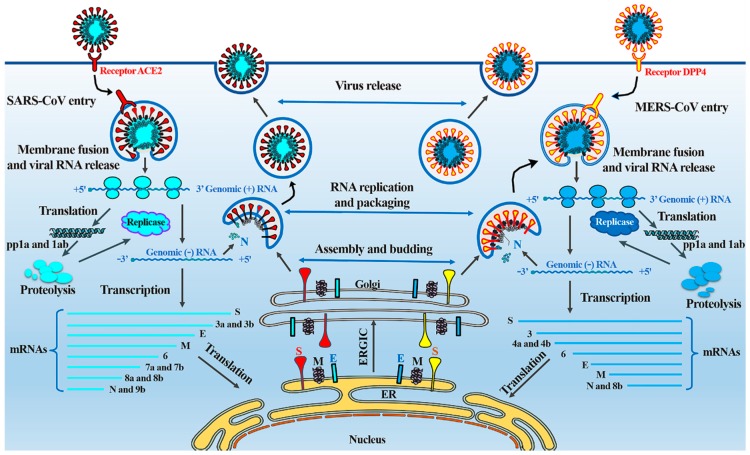Figure 2.
The life cycle of SARS-CoV and MERS-CoV in host cells. SARS-CoV and MERS-CoV enter target cells through an endosomal pathway. The S proteins of SARS and MERS bind to cellular receptor angiotensin-converting enzyme 2 (ACE2) and cellular receptor dipeptidyl peptidase 4 (DPP4), respectively. Following entry of the virus into the host cell, the viral RNA is unveiled in the cytoplasm. ORF1a and ORF1ab are translated to produce pp1a and pp1ab polyproteins, which are cleaved by the proteases that are encoded by ORF1a to yield 16 non-structural proteins that form the RNA replicase–transcriptase complex. This complex drives the production of negative-sense RNAs [(−) RNA] through both replication and transcription. During replication, full-length (−) RNA copies of the genome are produced and used as templates for full-length (+) RNA genomes. During transcription, a subset of 7–9 sub-genomic RNAs, including those encoding all structural proteins, is produced through discontinuous transcription. Although the different sub-genomic mRNAs may contain several open reading frames (ORFs), only the first ORF (that closest to the 5′ end) is translated. Viral nucleocapsids are assembled from genomic RNA and N protein in the cytoplasm, followed by budding into the lumen of the ERGIC (endoplasmic reticulum (ER)–Golgi intermediate compartment). Virions are then released from the infected cell through exocytosis. SARS-CoV, severe acute respiratory syndrome coronavirus; MERS-CoV, Middle East respiratory syndrome coronavirus; S, spike; E, envelope; M, membrane; N, nucleocapsid.

